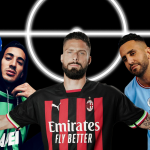
PUMA's new course between personalization and performance
The German brand is the one that has focused most on variety and social strategies. Will it have paid off?

August 12th, 2022
This season PUMA has proven to be one of the most versatile and dynamic brands in mixing together the rampant feline's trademark push for innovation and the heritage of the teams it sponsors. In particular, it has been the technical sponsor that has most customized jerseys for its flagship teams, neither relying on a one-size-fits-all template as Nike has done nor pushing the identity of the clubs as chosen by adidas. Compared to the two major players in the kit supplier world, PUMA has been able to carve out an important space for itself and enlarge it more each season, becoming no longer just the third wheel.
Bolstered by having signed with the two winning clubs of the most competitive leagues in Europe, Manchester City and AC Milan, PUMA has decided to up the ante for next season by working closely with the teams by customizing both the offer and the product launch. An attention to detail that made all the difference and that, regardless of the results of the jerseys themselves, testifies to how the German brand in this aspect is at least for this season ahead of everyone else. Just think of the production level of the videos made for the launches of the Manchester City jerseys, the first filmed in NASA's Houston Space Center with Kyle Walker disguised as an astronaut and the second in collaboration with Milan itself on the occasion of the return of the Citizen jersey inspired by the Rossoneri. The third kit, on the other hand, was even presented on Roblox with a dedicated tournament, another creative mode for not making unveiling kits boring.
A mode that PUMA has not only used for its top team, but has been an integral part of the aesthetics of promotion campaigns, using viral videos and formats borrowed from social trends. A look outside of football that has made a brand that is usually very focused on performance material breathe, and instead has been increasingly opening up to the world of fashion and lifestyle in recent times. A choice that can be understood by seeing the photoshoots taken for the jerseys of the two Serie A clubs, Milan and Sassuolo, in which the players wear the jersey like a fashion item. Milan's styling veered toward the classic, with pence pants and turtlenecks, while Sassuolo's was chasing the bloke-core trend with jeans and hoodie under the black-and-green shirt.
Bold choices not without their stumbles, but they trace the process behind PUMA's choices for jersey design as well, the ones that are ultimately the pinnacle of a sports brand's work. For the two Italian teams, PUMA followed the same concept, using a similar design but with minor differences to the pattern defined by the vertical stripes. The most noticeable is where the stripes end, with the Rossoneri ones reaching all the way up to the neck, thus creating a large front panel, while the black and green ones break off first, leaving a black horizontal dowel on which the technical sponsor's logo and the club's logo stand out. It's a way of enlivening the stripes on the jerseys of teams that have always used this pattern, one of the oldest in soccer history, which is a constant challenge for designers.
For Manchester City's second jersey, PUMA chose slanted lines to freshen up a classic pattern for the Citizens, while since it had not made a home jersey for Borussia with the stripes for more than five seasons, for this year it decided to reintroduce a more classic look with black vertical bars interrupted only by the sponsor in the center of the jersey. For Valencia, the historic La Senyera pattern is back, with stripes in the colors of the Comunidad Valenciana flag down to the V-neck, following a template also used for PSV and Rapid Vienna. A variety of approaches, styles, and references that might confuse and disorient the fan but perfectly tells of the German brand's new course outside the lines.








































.png)


.jpg)






